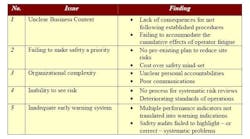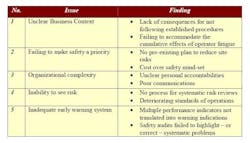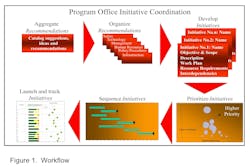BP Tackles Texas City Failings
The popular press has been filled with coverage of the tragic March 2005 explosion in BP’s Texas City, Texas refinery. Less well publicized are the successful steps BP has taken in recent months to establish safer and more stable operations in the near-term – and to develop a long-term plan to make the Texas City refinery one of the safest in the BP system. BP has made solid progress – led by a site-wide Texas City Program Office, established with the assistance of AlixPartners.
Although the sidebar details the direct causes and consequences of the Isomerization Plant (ISOM) explosion, the underlying reasons are complex. The final Fatal Accident Investigation Report identifies five underlying cultural issues (Figure 1).
Restoring Texas City’s safety and performance requires a comprehensive and far-reaching program going well beyond mere technical refinements. Corrective action must address failings in management, culture and control.
Initial Move
BP’s first action following the accident was to install veteran Colin MacLean, a proven leader with more than 30 years’ experience in turn-around management, as the refinery’s new Business Unit Leader. His charge was monumental: turn one of the largest, most complex, and – in the minds of many observers – most notorious refineries in the world into a safer, simpler and consistently performing operation. Consider the complications confronting him on his arrival: emotions were still running high among the 2,600 workers on site – many of whom were personally affected by the tragedy; incumbent site management held a wide array of opinions on remediation actions; BP’s corporate leadership mandated that necessary steps be taken to restore the refinery; and a wide range of federal and state authorities (including EPA, OSHA and the Chemical Safety Board) and local groups were scrutinizing the site. All were pressing for major changes.
Today, just slightly after the first anniversary of the disaster that brought the attention of the world to Texas City, the refinery is becoming a very different place. Safety is the priority at the site, and more than 500 discrete safety-enhancing and performance-enhancing initiatives are scheduled for implementation. Planning extends over a 7-year period – led by MacLean under the direction of the Texas City “Focus on the Future” Program Office. Daily production at the site is being meticulously brought back on line following a complete production stoppage precipitated by Hurricane Rita’s approach. Most importantly, the site’s safety incident rates continue to improve and safety now takes precedence over production.
Texas City is one of the world’s largest and most complex refineries. It accounts for 17% of BP’s global capacity — 460,000 barrels/day of crude distillates — 3% of U.S. refinery capacity. The facility first began operation in 1934. It was acquired by Amoco in 1947 and has been expanded a number of times since then. The BP-Amoco merger brought the Texas City refinery into the BP network in 1999. Today’s compound comprises some 30 refinery units spread over 1,200 acres.
Regaining Control
After the March 2005 explosion, BP had rapidly begun organizing a response. On his arrival at the site, MacLean realized that BP needed to accelerate the pace of the plant’s safety recovery efforts, and decided to implement and run a site-wide Program Office mandated to organize, coordinate and communicate an integrated response to better safeguard workers. MacLean was frank about the immediate situation necessitating this approach: “We had too many development initiatives. We had lost focus. Events of 2005, particularly the ISOM explosion, made us recognize how much we had to do. We needed to develop a five- to seven-year program that we knew would be in the multi-billion dollar range.”
MacLean quickly recognized a need for external assistance. He needed to augment his team’s skills and abilities with practical guidance and a results-oriented approach. MacLean chose the global turnaround and crisis management firm AlixPartners for the task. When asked how he made this choice, MacLean said, “Based on previous experience with [AlixPartners professionals] at our chemicals plant in Grangemouth, we knew they had resources with the track record, experiences and frameworks to support our strategy and needs. Our confidence in their capabilities allowed us to sole source this on short notice.”
A small team of AlixPartners resources mobilized and was on the ground within days of MacLean’s call. BP dedicated Tim Wilk, previously of Texas City’s Strategic Planning Group, to become head of the newly established “Texas City Focus on the Future” Program Office. Figure 2 shows the workflow approach developed by the Program Office, which rapidly mobilized to:
- Solicit and catalog hundreds of specific improvement recommendations,
- Detail, organize and rationalize the recommendations into a logical structure,
- Develop focused and action-oriented improvement initiatives in response to site
objectives and the recommendations, - Prioritize and sequence the initiatives into a fully integrated, multi-year safety and
performance enhancement program, - Approve, resource and drive each of the initiatives as it was launched,
- Serve as a site-wide communications ‘clearing-house’
- Build-out a world-class Program Office and enable BP to manage and drive
implementation on an ongoing basis.
The Program Office’s initiatives span everything from near-term and tactical actions to longer-term and strategic programs. Two examples of near-term activities to quickly address work force safety are: Trailer Removal, and Limiting Traffic. Relocating non-essential activities away from hazardous areas and implementing a shuttle bus system reduces parking and traffic near these areas. Many initiatives address more complex and longer-term changes. One example is Leadership Capability Development, aimed at creating improved management practices in support of safety and personal accountability.
Another contrasting example includes Control of Work, which addresses such complex issues as project control and delegation of authority for maintenance and project work conducted throughout the refinery. All together, the totality of current and prospective initiatives presents a challenging task for the Program Office. It must respond to an environment constantly in flux by closely monitoring developments and revisiting priorities.
Anatomy of the Accident
(Excerpted from the Fatal Accident Investigation Report issued December 9, 2005)
Fifteen people were killed and over 170 harmed as a result of a March 23, 2005 fire and explosion on the Isomerization Plant (ISOM) at the BP Products North America owned and operated refinery in Texas City, Texas.
The incident was an explosion caused by heavier-than-air hydrocarbon vapors combusting after coming into contact with an ignition source, probably a running vehicle engine. The hydrocarbons originated from liquid overflow from [a] blowdown stack (vent and receptacle for collecting liquids) following the operation of [a processing unit’s] overpressure protection system caused by overfilling and overheating of [its] contents.
The failure to institute liquid rundown (discharge flow) from the tower, and the failure to take effective emergency action, resulted in the loss of containment that preceded the explosion. These were indicative of the failure to follow many established policies and procedures. Supervisors assigned to the unit were not present to ensure conformance with established procedures, which had become custom and practice on what was viewed as a routine operation.
The severity of the accident was increased by the presence of many people congregated in and around temporary trailers which were inappropriately sited too close to the source of relief. Many of those injured could have been warned and left the area safely had warning been provided by those who were aware of events. It is unclear why those aware of the process upset failed to sound a warning. The likelihood of this incident could have been reduced by discontinuing the use of the blowdown stack for light end hydrocarbon service and installing inherently safer options when they were available.
The investigative team found no evidence of anyone consciously or intentionally taking actions or decisions that put others at risk.
Major Challenges
From the earliest days of the Program Office, it became apparent that it would have to overcome major barriers to success – particularly given the need to create and sustain a fast pace. To navigate through literally hundreds of ideas on how to improve safety and operations, the Program Office rigorously focused on overcoming the following key issues:
- Refinery size and complexity – the size and intricacy of the Texas City refinery makes its operation inherently challenging. The Program Office served as a site-wide mechanism to focus energy and resources on the highest-leverage areas of impact thus improving both speed and likelihood of success for each initiative.
- Workforce morale – it is difficult to convey in writing the emotional distress to employees resulting from the accident at Texas City. Improved communication and conspicuous progress with high-profile initiatives have rejuvenated spirits.
- Prioritization of activities – unit managers within the refinery each had their own agendas with unique lists of actions being individually pursued. There was redundancy and competition for scarce resources. Although the frenetic efforts going on throughout the site were well meaning, a common direction was required. By quickly performing a site-wide prioritization exercise, the Program Office developed a common perspective across the refinery.
- Internal communication – functional specialization exacerbated a sense of isolation and independence across operating units and functions that should have operated as a network. The Program Office’s on-site ‘war room’ became a gathering place to share information and solicit input from all site constituencies.
- Emphasis on commercial performance – an old aphorism suggests, “Any strength taken to an extreme can become a liability.” BP’s international recognition for commercial success is not accidental. However, a focus on financial optimization de-emphasized concern for safety. BP leadership made it clear in thought and deed that dramatic safety improvement was the overriding priority.
AlixPartners drew upon its expertise in crisis management and its proprietary Program Office methodology to engage the entire site leadership. Working closely with MacLean, Wilk and the members of the internal Program Office team, momentum began to build.
Texas City’s Path Ahead
The ISOM accident remains fresh in the minds of all those working in Texas City even while the national news turns its attention to the record-setting profits for oil producers. Creating a safer, simpler and more reliable refinery remains the Texas City site’s overarching goal. In support of this, BP is incrementally adding skilled resources to build capabilities in its Program Office. Transparency is one of their goals. Communicating progress to site employees has become an essential function of this office. Now, since the accident, employees can monitor developments beyond their own unit or department.
The Program Office approach employed at Texas City has proven so effective that BP has replicated it globally throughout its refining operations. Each initiative’s status from Texas City and from each of BP’s four other US refineries merge together at the US Program Office in Chicago. This information, in turn, flows to BP’s global headquarters in London along with similar feeds from other refineries around the world. Operational risks remain, however BP continues on its path to progress. The Program Office has become the instrument to making the Texas City refinery a safe place to work — site-wide coordination, better communication and clear leadership are the keys to success.
Foster Finley and Karl Roberts are Directors in AlixPartners’ Performance Improvement Practice. Their offices are in New York and Los Angeles, respectively. Email them at [email protected] or [email protected].




